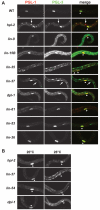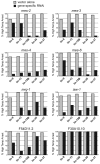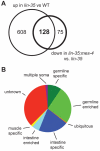synMuv B proteins antagonize germline fate in the intestine and ensure C. elegans survival
- PMID: 21343362
- PMCID: PMC3042865
- DOI: 10.1242/dev.059501
synMuv B proteins antagonize germline fate in the intestine and ensure C. elegans survival
Abstract
Previous studies demonstrated that a subset of synMuv B mutants ectopically misexpress germline-specific P-granule proteins in their somatic cells, suggesting a failure to properly orchestrate a soma/germline fate decision. Surprisingly, this fate confusion does not affect viability at low to ambient temperatures. Here, we show that, when grown at high temperature, a majority of synMuv B mutants irreversibly arrest at the L1 stage. High temperature arrest (HTA) is accompanied by upregulation of many genes characteristic of germ line, including genes encoding components of the synaptonemal complex and other meiosis proteins. HTA is suppressed by loss of global regulators of germline chromatin, including MES-4, MRG-1, ISW-1 and the MES-2/3/6 complex, revealing that arrest is caused by somatic cells possessing a germline-like chromatin state. Germline genes are preferentially misregulated in the intestine, and necessity and sufficiency tests demonstrate that the intestine is the tissue responsible for HTA. We propose that synMuv B mutants fail to erase or antagonize an inherited germline chromatin state in somatic cells during embryonic and early larval development. As a consequence, somatic cells gain a germline program of gene expression in addition to their somatic program, leading to a mixed fate. Somatic expression of germline genes is enhanced at elevated temperature, leading to developmentally compromised somatic cells and arrest of newly hatched larvae.
Figures







Similar articles
-
C. elegans synMuv B proteins regulate spatial and temporal chromatin compaction during development.Development. 2019 Oct 9;146(19):dev174383. doi: 10.1242/dev.174383. Development. 2019. PMID: 31515206 Free PMC article.
-
Repression of germline RNAi pathways in somatic cells by retinoblastoma pathway chromatin complexes.PLoS Genet. 2012;8(3):e1002542. doi: 10.1371/journal.pgen.1002542. Epub 2012 Mar 8. PLoS Genet. 2012. PMID: 22412383 Free PMC article.
-
gon-14 functions with class B and class C synthetic multivulva genes to control larval growth in Caenorhabditis elegans.Genetics. 2006 Feb;172(2):915-28. doi: 10.1534/genetics.105.048751. Epub 2005 Dec 1. Genetics. 2006. PMID: 16322520 Free PMC article.
-
Chromatin regulation during C. elegans germline development.Curr Opin Genet Dev. 2003 Oct;13(5):455-62. doi: 10.1016/s0959-437x(03)00109-6. Curr Opin Genet Dev. 2003. PMID: 14550409 Review.
-
Specification of the germ line.WormBook. 2005 Jul 28:1-10. doi: 10.1895/wormbook.1.9.1. WormBook. 2005. PMID: 18050414 Free PMC article. Review.
Cited by
-
A Forward Genetic Screen for Suppressors of Somatic P Granules in Caenorhabditis elegans.G3 (Bethesda). 2015 Jun 22;5(10):2209-15. doi: 10.1534/g3.115.019257. G3 (Bethesda). 2015. PMID: 26100681 Free PMC article.
-
The DREAM complex functions as conserved master regulator of somatic DNA-repair capacities.Nat Struct Mol Biol. 2023 Apr;30(4):475-488. doi: 10.1038/s41594-023-00942-8. Epub 2023 Mar 23. Nat Struct Mol Biol. 2023. PMID: 36959262 Free PMC article.
-
RNA granules in germ cells.Cold Spring Harb Perspect Biol. 2011 Dec 1;3(12):a002774. doi: 10.1101/cshperspect.a002774. Cold Spring Harb Perspect Biol. 2011. PMID: 21768607 Free PMC article. Review.
-
The mir-35 Family Links Maternal Germline Sex to Embryonic Viability in Caenorhabditis elegans.G3 (Bethesda). 2019 Mar 7;9(3):901-909. doi: 10.1534/g3.118.200863. G3 (Bethesda). 2019. PMID: 30679246 Free PMC article.
-
Caenorhabditis elegans SynMuv B gene activity is down-regulated during a viral infection to enhance RNA interference.bioRxiv [Preprint]. 2024 Jul 16:2024.07.12.603258. doi: 10.1101/2024.07.12.603258. bioRxiv. 2024. PMID: 39071373 Free PMC article. Preprint.
References
-
- Altun Z. F., Hall D. H. (2009). Alimentary system, intestine. In WormAtlas, doi:10.3908/wormatlas.1.4
-
- Beitel G. J., Lambie E. J., Horvitz H. R. (2000). The C. elegans gene lin-9,which acts in an Rb-related pathway, is required for gonadal sheath cell development and encodes a novel protein. Gene 254, 253-263 - PubMed
-
- Bender A. M., Wells O., Fay D. S. (2004). lin-35/Rb and xnp-1/ATR-X function redundantly to control somatic gonad development in C. elegans. Dev. Biol. 273, 335-349 - PubMed
-
- Bender L. B., Cao R., Zhang Y., Strome S. (2004). The MES-2/MES-3/MES-6 complex and regulation of histone H3 methylation in C. elegans. Curr. Biol. 14, 1639-1643 - PubMed
Publication types
MeSH terms
Substances
Grants and funding
LinkOut - more resources
Full Text Sources
Molecular Biology Databases
Research Materials
Miscellaneous

